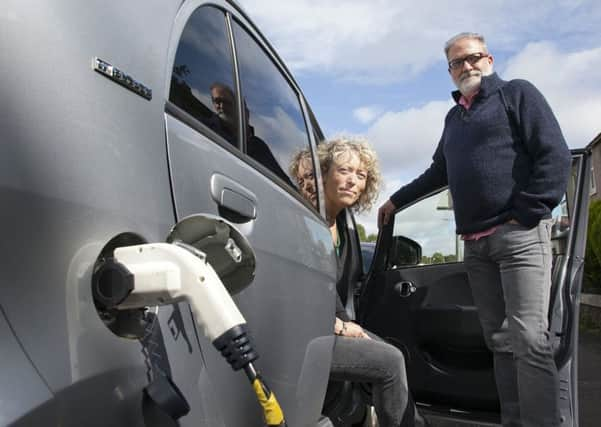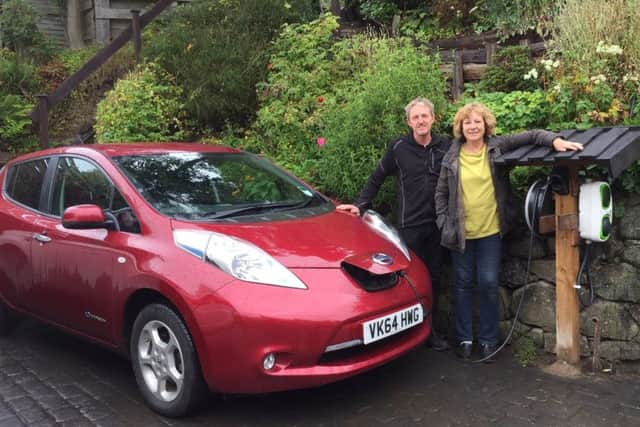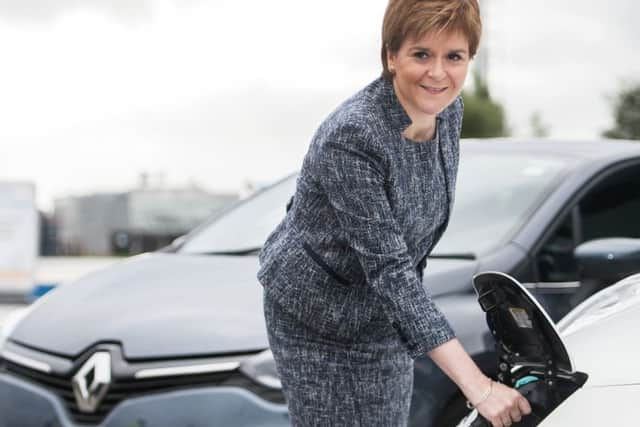Insight: Plugged in to the electric future of motoring


Self-confessed “tree-huggers” Ron and Tricia Neville are objects of curiosity in the village of Abernyte in Perthshire. “There was a bit of a stir when we put in the solar panels and we also have an air source heat pump; getting an electric car was the final thing,” says Ron, a retired GP. “It made the village laugh, but I think there’s also a sneaking admiration that we’ve taken the plunge.”
Their maroon Nissan Leaf, nicknamed “Rowan”, is their pride and joy. An ex demonstrator car, they picked it up for just £10,000. (New Leafs are £24,000, reduced to £19,000 by a £5,000 Scottish Government grant.) With a driving range of between 100 and 120 miles, they say it is great for tootling around the local area.
Advertisement
Hide AdAdvertisement
Hide AdThey charge the car at night on their driveway, using energy from their solar panels when possible, and can make several trips to and from Perth or Dundee on a single charge.


If they should require a battery boost while out and about, they have a phone app which points them in the direction of their nearest public charging point and tells them if it’s working and/or in use.
“I don’t know if smugness is one of the seven deadly sins,” says Ron, “but you do feel smug because every second week you are not shelling out £50 on something you know is polluting the atmosphere.”
In Edinburgh, Ewan and Hilary Aitken are also early adopters; wanting to lead by example, the couple gave up their petrol car back in the mid-2000s when Ewan, then an Edinburgh City Councillor, was pushing for a city centre congestion charge. A decade on, however, Hilary – head of the city’s literacy and dyslexia support service – was finding it difficult to travel from school to school by bus, so, in 2014, they bought a Peugeot iOn for less than half price (£12,000).
“Even at £12,000 it cost considerably more than an equivalent. We were prepared to do that because it meant Hilary could do lots of short journeys without putting all the pollution in,” says Ewan.


“We can plug it into a 13 amp plug in our front garden. It costs £2.50 to fully charge. It has a range of 70 miles, but there are 35 charge points around the city in hotels, car parks, supermarkets and community centres. And I think you drive differently – less aggressively – in an electric car,” he says.
Yet for all their enthusiasm, both couples also rely on a fall-back vehicle. At present, the limited range, the number of charging points and length of time it takes to recharge (three to four hours for a slow charger, half an hour for a rapid one) make them less practical for long journeys.
Thus, when Ewan needs to make an extended trip – perhaps once a month – he hires a car for the day. The Nevilles’ second car is a hybrid Mitsubishi Outlander for the same reason.
Advertisement
Hide AdAdvertisement
Hide AdLast week, the First Minister Nicola Sturgeon set the target for phasing out petrol and diesel cars at 2032 – eight years earlier than the Westminster government’s UK deadline.


In order to hit that target, she pledged to fast-track a nationwide network of chargers, make the A9 the country’s first electrically enabled highway (with chargers all along the 240-mile route), introduce low emission zones in Scotland’s four biggest cities (with offenders fined for non-compliance) and set up a £60 million innovation fund to overcome some of the technological challenges, including the problem of charging in heavily tenemented areas.
To those motorists still wedded to conventional vehicles, this deadline may seem over-ambitious. Sure, the number of Scottish drivers buying electric and hybrid cars is increasing (up 80 per cent last since February) but it still amounts to fewer than 4,000 cars out of a total of 2.7 million.
Will incentives such as the £5,000 grant (£2,500 for hybrids), the free installation of domestic charging stations and the free use of the ChargePlace Scotland network of charge points be enough to win people over?
And if it is, will the infrastructure be adequate to meet those motorists’ needs? Or, come 2032, will a trip to the north coast involve extended journey times, convoluted travel plans and frayed tempers as you sit in long queues waiting to use a charging station?


There are other questions too: about the capacity of the National Grid to cope with greater demands at peak times, whether or not we will have enough technicians trained to deal with the cars’ high-voltage systems and how Sturgeon can enforce a ban when vehicle registration is reserved to Westminster.
And yet, with oil supplies dwindling, hurricanes in the Caribbean focusing minds on climate change, and a succession of European countries announcing similar deadlines, we do seem to have reached a watershed moment.
Where US pioneer Tesla has led, others are following, with more and more manufacturers committing to abandoning fossil fuels. BMW has said it hopes to have 25 electrified vehicles by 2025 (12 of them fully electric), while Volvo and Jaguar Land Rover plan to make only hybrid and electric vehicles from 2020.
Advertisement
Hide AdAdvertisement
Hide AdAs technology advances, the cars become more functional and the distance they can be driven on a single charge increases. Tesla’s elite Model S has a range of up to 300 miles. Nissan has suggested an enhanced version of the second generation Leaf will match it, while BMW announced its i5, to be unveiled at the Frankfurt Motor Show later this week, will have a range of up to 435 miles (which would take you all the way from Glasgow to London).
At the same time, prices are gradually coming down. Half a million people have already put down a $1,000 deposit on Tesla’s first mass-produced entry level Model 3, which will be released next year and cost £26,500; and the new Nissan Leaf – featuring auto-parking technology – will cost £22,700. Meanwhile, the cost of running an electric car is estimated at just 2p a mile.
Douglas Robertson, director of the Electric Vehicle Association Scotland (EVAS) believes a confluence of all these factors means Scotland will hit its target a few years ahead of schedule.
“When I bought my first electric car in 2013, it had a range of 70 or 80 miles and there were just four rapid chargers in the whole of Scotland,” Robertson says.”To plan a journey to go and visit my brother from Perth to Kilmarnock was quite traumatic, because I had to make sure I could get somewhere to charge en route.
“My next electric car, which I hope to buy at the beginning of next month, will have a range of about 150 miles, so immediately I can go from Perth to Kilmarnock and possibly back again without stopping.
“Also, there are now around 200 rapid chargers in Scotland and – if you are driving down to England – there are Ecotricity chargers [which you have to pay for] at every motorway service station.
“We are a little bit frustrated things are not happening as quickly here as they are in Norway [where Oslo is recognised as the EV capital of the world]. On the other hand, everything the Scottish Government has announced on this has been positive.
“There has also been a big increase in both local authority and utility company fleets in the past 12 months so we are moving in the right direction.”
Advertisement
Hide AdAdvertisement
Hide AdNot that Robertson underestimates the scale of the task that lies ahead; while greater driving ranges reduce the number of times an individual motorist needs to recharge, the overall increase in electric car ownership will nonetheless increase pressure on the network.
There are now more than 700 ChargePlace Scotland chargers across the country (most of them free), but how many more will be needed to fulfil the Scottish Government’s pledge, and where will we put them?
“One of the things I have been saying for a while, is that they need to develop hubs with multiple rapid chargers,” says Robertson.
“Some of these are already beginning to spring up. In Perth, we have a three-charger hub, a two-charger hub and a single charge. And in Dundee, they are creating three hubs – one of which has six rapid chargers and solar panels.
“We want the Scottish Government to place these hubs in strategic places. Also they have to consider people in tenements who cannot charge at home. Those people need either access to a rapid charge hub or on-street charging facilities.
“There are already pilots [for on-street charging] in parts of Edinburgh. But they are throwing up human problems, such as people continuing to take up the parking spaces once their batteries are fully charged,” says Robertson.
Of course, multi-charge hubs require a large supply of electricity. To help ease pressure on the grid they could be powered by second-life batteries charged slowly at times when demand is low, and then discharged into the car battery as required. “If you go to Gretna Green, you will find eight Tesla superchargers (for Tesla-owners only) fed from a battery storage bank in a 20ft container beside the line of chargers,” Robertson says.
Pressure on the grid could also be eased using smart meters. At peak periods energy consumption may rise to 56GW, but at night it can drop to 20GW. The meters would stagger consumption, making sure the cars only recharge their batteries when demand is at its lowest.
Advertisement
Hide AdAdvertisement
Hide AdThis technology is already being used by the Nevilles. They plug their car into their charge station when they come home, but a timer ensures it doesn’t click into action until they are asleep.
Recharging at night could be incentivised by a system of dynamic pricing – as in the US – where electricity consumed at peak times can be ten times more expensive than electricity consumed off-peak.
Research is also continuing into the concept of vehicle-to-grid technology which would see batteries in parked cars feeding energy back into the electric distribution network. Future car-owners who provide this service stand to earn an estimated £1,000 to £2,000 a year to further defray purchase and running costs.
At Edinburgh Napier University’s Transport Research Institute, Professor Tariq Muneer insists Scotland is well-placed to lead an electrical revolution because it has already cut its carbon footprint significantly through wind farms.
“If your electricity comes from fossil fuels then it does not make any sense to switch to electric cars because they will simply emit more CO₂ into the atmosphere. But Scotland has taken a lead with wind and its carbon footprint is relatively low, so it is in a good position.”
One of the Transport Research Institute’s projects involves finding new ways to heat electric cars; unlike conventional cars, they don’t produce waste heat which can then be used to heat the interior. “We have found that in the depths of winter 40 per cent of the traction energy is being used to heat the car: that’s a significant proportion of the total and it reduces the driving range,” he says.
The team have been experimenting with solar panels on electric car roofs in the hope they will provide power to heat the interior in winter and cool it in summer, without any impact on traction energy.
Other radical ideas include the creation of “electric motorways” that charge up your battery as you drive along them. “You can already use induction pads to charge your electric car in your garage, but we could eventually see that technology introduced to highways,” says Muneer. “There could be, say, a 10km stretch of road with 1km of induction charging pads placed at regular intervals. It would be similar to a train getting electricity from a cable.”
Advertisement
Hide AdAdvertisement
Hide AdDavid Woods – technology expert and author of How Apollo Flew to the Moon – is also an electric car zealot; at present he drives a Nissan Leaf, but has put his $1,000 on a Tesla Model 3 and believes it will be worth the wait.
“The west coast and north coast of Scotland is already quite well-served for chargers,” he says. “I recently went to the far side of the Kintyre peninsula beyond Lochgilphead and I had choices all the way: I could charge in Arrochar, in Balloch – though the Balloch charger was broken – Inverary and Lochgilphead. When we got to the caravan site, they were happy for us to plug in there. At the moment, however, they are mostly single charge points. You would want to see banks installed – and to have them every 30 or so miles.”
The big challenge, for governments and manufacturers alike is to make driving electric cars attractive to people who do not consider themselves “tree-huggers”. In Woods’ experience all that is required is to give them a taste of what they’re missing.
“I take friends out for short trips and you just watch the preconceptions falling away,” he says. “They realise one, it’s just a car, and two, it’s very serene, very quiet, very quick off the mark. There’s not much you can say against it; you’d have to be stuck in the past not to embrace it.”